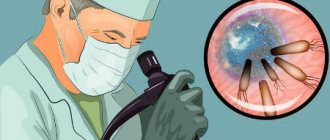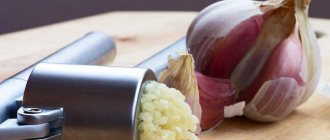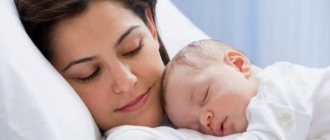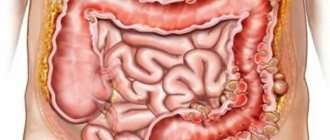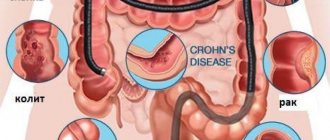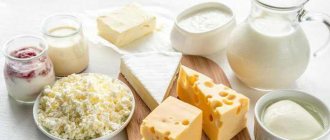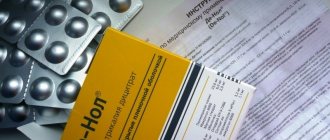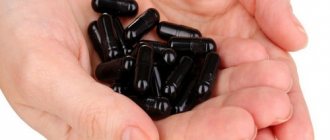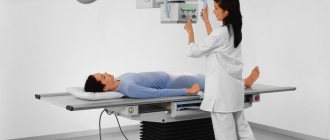Restoration of normal bowel function takes place under the supervision of the attending physician. Nutrition after intestinal colonoscopy is a key point in the prevention of complications after manipulation. To restore intestinal function as quickly as possible, a gentle menu with small, frequent meals is introduced.
The products used are easily digestible, with a large amount of vitamins and minerals, and are not capable of injuring the intestinal walls. Often, after a colonoscopy and following a diet, patients forget about the sense of proportion, the need to restore normal intestinal functioning gradually, including excluded foods in the diet in small doses. This can lead to complications - constipation, diarrhea, bloating, gas, bleeding.
Patient's intestines
To eliminate the chance of causing constipation, you should remember to maintain water balance and drink at least 2-2.5 liters of water per day. It is recommended to create a menu taking into account 6-7 meals with an interval of 1.5-2 hours. 30-40 minutes before eating, you need to drink 1 glass of water. Food is not washed down with liquid. For the effective functioning of gastric juice and complete digestion of food, it is important to pause for 40 minutes. Food should be warm: the temperature of cold dishes is above 15 degrees, hot dishes - up to 62 degrees.
Authorized products
After a colonoscopy, foods based on easy-to-digest foods are allowed:
- Soups based on broths made from vegetables, lean fish (cod, flounder, pollock, tuna, halibut, blue whiting, mullet, trout), poultry (chicken, turkey);
- Boiled egg, soft-boiled, omelette cooked in a steam bath;
- Boiled fish of lean varieties;
- Fish cooked using a steam bath;
- Porridge made from oatmeal, rice, buckwheat, semolina, without milk;
- Fresh, stewed, boiled, steamed vegetables;
- Curds, kefir, yogurt, fermented baked milk;
- Soaked dried fruits;
- Rosehip infusion, herbal teas, compotes, jelly;
- Marshmallows, marmalade, honey;
- Grain, rye bread.
Products for restoring intestinal microflora
Therefore, they are prescribed a special diet high in fermented milk products and fiber, which is found in fruits and vegetables. Additionally, a number of drugs with spores of beneficial microorganisms are used (“ Linex ”, “ Bifidumbacterin ”).
However, the role of intestinal dysbiosis in domestic medicine is greatly exaggerated. There is no convincing data yet on the role of microflora disorders in the development of negative symptoms after colonoscopy. They are advised to be included in the concept of “irritable bowel syndrome”. It develops due to mechanical pressure on the walls, microtraumatization of the mucous membrane and impaired motility. Usually, even without special treatment, the syndrome goes away after 2-3 days with a properly selected diet.
Prohibited Products
Excluded from food:
- Fried meat products, fish;
- Sausages, canned products, smoked meat, pickles, marinades;
- Whole grain porridge;
- Lentils, chickpeas, beans, peas, rice;
- Confectionery;
- Bakery;
- Pasta;
- Radish, radish, onion, garlic;
- Mushrooms in any form;
- Fried egg;
- Freshly ground coffee;
- Products containing cocoa beans;
- Alcohol;
- Spicy, fatty dishes.
Authorized Products
There is a separate list of food ingredients, the use of which will not adversely affect the quality of colonoscopy diagnostics. It is necessary to create a daily diet taking into account those foods that will be listed below. Such products include:
- Cereals: corn, oat flakes, rice, buckwheat, millet.
- Dairy and fermented milk products: homemade kefir or yogurt, low-fat cottage cheese, tofu cheese, ricotta, gouda, Adyghe cheese, feta cheese.
- Vegetable ingredients: pumpkin pulp, zucchini, onions, carrots, red beets, broccoli or cauliflower. In addition, corn, potatoes and daikon are allowed in minimal quantities. It is recommended to cook vegetable dishes baked, stewed, or steamed.
- Meat ingredients: rabbit, chicken, venison, turkey, veal or beef. The listed types of meat are recommended to be baked or stewed.
- Seafood and fish ingredients: flounder, milk hake, perch, pike perch, saury, blue whiting, cod, pollock, scallops, mussels, squid and shrimp.
- Egg products. It is permissible to consume chicken or quail eggs, soft-boiled or poached, in small quantities.
- Herbs and greens: cilantro, celery leaves, dill, green onions, parsley, basil.
- Fruit and berry ingredients: bananas, strawberries, strawberries, pears, apples, citrus fruits, melons, blackberries, blueberries, apricots and peaches.
- Groceries: bread made from wholemeal wheat flour, pasta made from durum wheat, crackers from wheat bread, diet or biscuits, muesli without adding nuts and dried fruits.
- Spices and seasonings: cinnamon, turmeric, coriander, fresh ginger root.
- Drinks: mineral water without carbon dioxide, chicory root drink, fruit and berry compote diluted with water 1:1, freshly squeezed fruit and berry juices, weak black or green tea, and hibiscus.
- Oil: it is allowed to add flaxseed, sunflower or olive oil to prepared dishes in small quantities.
Example menu
As an indicative menu for the week, you can use the following option:
1st day:
- Breakfast: thin porridge, tea;
- Second breakfast: curd mass;
- Lunch: vegetable puree soup, boiled breast;
- Afternoon snack: kefir;
- Snack: yogurt;
- Dinner: buckwheat porridge, boiled meat.
Day 2:
- Breakfast: cottage cheese casserole, jelly;
- Second breakfast: compote;
- Lunch: chicken broth with dumplings;
- Afternoon snack: kefir;
- Snack: yogurt, banana;
- Dinner: stewed vegetables.
3rd day:
- Breakfast: steamed omelette, tea;
- Second breakfast: fermented baked milk;
- Lunch: milk noodle soup;
- Afternoon snack: curd mass;
- Snack: apple compote;
- Dinner: steamed fish, mashed potatoes.
4th day:
- Breakfast: rice porridge, compote;
- Second breakfast: peach;
- Lunch: mixed vegetable soup (without cabbage);
- Afternoon snack: jelly, apple pie;
- Snack: rosehip infusion;
- Dinner: zucchini stuffed with meat and rice.
Day 5:
- Breakfast: soft-boiled egg, tea with milk;
- Second breakfast: yogurt, apple;
- Lunch: chicken breast baked with cheese, baked vegetables;
- Afternoon snack: kefir;
- Snack: jelly from yogurt, cottage cheese, fruit;
- Dinner: boiled rice, boiled meat stew.
Day 6:
- Breakfast: oatmeal porridge, tea;
- Second breakfast: stewed apple and carrot salad;
- Lunch: meat baked in sour cream sauce; boiled rice;
- Afternoon snack: fermented baked milk;
- Snack: tea;
- Dinner: boiled fish, baked potatoes.
Day 7:
- Breakfast: steamed omelet, tea;
- Second breakfast: curd mass, banana;
- Lunch: pilaf with fruit, steamed vegetables, bread containing bran;
- Afternoon snack: rosehip infusion, crackers;
- Snack: jelly, fruit;
- Dinner: baked meat with potatoes, boiled meat pilaf, tea.
Portions should be kept small, each meal is calculated based on 200-250 g of ready-made dishes in total, not including tea. Between meals, you should follow the rule: drink a glass of water 40 minutes after eating. The attending physician may recommend other menu options, taking into account the patient’s well-being before the colonoscopy and after the manipulations. The menu option shows that recovery after the procedure can take place with adequate nutrition, without compromising the sense of taste.
Example of a weekly menu
In order not to look at the list before each meal, we have selected an approximate menu for the week, which patients after a colonoscopy can fearlessly take on board.
Day 1
Breakfast : thin oatmeal, herbal tea.
Lunch : steamed omelette, weak black tea.
Lunch : creamy pumpkin soup, chicken meatballs with mashed potatoes, compote.
Afternoon snack : natural marshmallows, still mineral water.
Dinner : cod fish casserole, diluted apple juice.
Before bed : a glass of kefir.
Day 2
Breakfast : 2 soft-boiled eggs, rosehip drink.
Lunch : toast with cheese, green tea.
Lunch : perch fish soup, veal hedgehogs with zucchini puree, dried fruit compote.
Afternoon snack : cottage cheese with banana, still water.
Dinner : bulgur with seafood in cream sauce, tea with honey.
Before bed : a glass of fermented baked milk.
Day 3
Breakfast : couscous porridge with strawberries, weak black tea.
Lunch : cottage cheese casserole, herbal tea.
Lunch : cream cheese soup, steamed pike perch with baked cauliflower, rosehip drink.
Afternoon snack : fruit jelly with natural whipped cream, still water.
Dinner : veal roll with omelet filling, apple juice.
Before bed : drinking yogurt.
Day 4
Breakfast : wheat porridge with fruit infusion, lemon balm tea.
Lunch : steamed cheesecakes, weak coffee.
Lunch : chicken soup with vegetables, tilapia baked on a potato bed, apple compote.
Afternoon snack : marshmallows, green tea.
Dinner : vegetable stew with turkey, pumpkin juice.
Before bed : a glass of kefir.
Day 5
Breakfast : bulgur with dried fruits, weak coffee.
Lunch : soft cheese with honey, rosehip infusion.
Lunch : vegetable soup with beef meatballs, rabbit stewed in sour cream, with mashed potatoes, apple juice.
Afternoon snack : apple-banana smoothie, biscuits.
Dinner : zucchini boats with minced chicken, still water.
Before bed : a glass of fermented baked milk.
Day 6
Breakfast : oatmeal jelly, sweet apple.
Lunch : cottage cheese-banana casserole, green tea.
Lunch : natothenia fish soup, veal meatballs with buckwheat, dried fruit compote.
Afternoon snack : honey cakes, still water.
Dinner : stuffed bell peppers, rosehip drink.
Before bed : natural yogurt.
Day 7
Breakfast : buckwheat porridge with berries, weak coffee.
Lunch : cottage cheese with cherry jam, still mineral water.
Lunch : milk noodle soup, chicken wings baked in honey, stewed vegetables, fruit and berry jelly.
Afternoon snack : oatmeal cookies, apple juice.
Dinner : fish aspic, apple-banana smoothie.
Before bed : milkshake with banana.
The given diet is advisory in nature. Any of its components can be changed in accordance with general recommendations and personal preferences.
Many patients believe that they only need to follow a special diet before a colonoscopy and forget about further precautions. Such a frivolous attitude can lead to unwanted complications, which can easily be avoided by following simple recommendations. Be more attentive to your health, and if unpleasant symptoms occur or your health worsens, be sure to notify your doctor.
Restoration of normal bowel function takes place under the supervision of the attending physician. Nutrition after intestinal colonoscopy is a key point in the prevention of complications after manipulation. To restore intestinal function as quickly as possible, a gentle menu with small, frequent meals is introduced.
The products used are easily digestible, with a large amount of vitamins and minerals, and are not capable of injuring the intestinal walls. Often, after a colonoscopy and following a diet, patients forget about the sense of proportion, the need to restore normal intestinal functioning gradually, including excluded foods in the diet in small doses. This can lead to complications - constipation, diarrhea, bloating, gas, bleeding.
To eliminate the chance of causing constipation, you should remember to maintain water balance and drink at least 2-2.5 liters of water per day. It is recommended to create a menu taking into account 6-7 meals with an interval of 1.5-2 hours. 30-40 minutes before eating, you need to drink 1 glass of water. Food is not washed down with liquid. For the effective functioning of gastric juice and complete digestion of food, it is important to pause for 40 minutes. Food should be warm: the temperature of cold dishes is above 15 degrees, hot dishes - up to 62 degrees.
Nutrition after colonoscopy under anesthesia
Colonoscopy is an endoscopic method for examining the large and small parts of the intestine. An invasive (internal, performed using the introduction of special instruments) examination is performed, which, for certain indications, involves manipulation under anesthesia. In this case, a diet with a large number of restrictions is prescribed.
A few hours after anesthesia, a few sips of plain water are allowed. If the intake of fluid is accepted positively by the body, without nausea or vomiting, the amount of water drunk gradually increases. You can only drink filtered, bottled or boiled water, with a range of 20-30 minutes.
In the first days you should not eat or drink:
- Milk;
- Carbonated drinks;
- Products containing large amounts of plant fiber;
- Sugar-containing concentrated syrups.
The correct dietary table includes a phased transition from liquid to more solid foods:
- For the first day or two, it is possible to eat exclusively liquid food (broths made from white poultry meat);
- After a couple of days, the patient is given pureed low-fat soups and broths, low-fat yoghurts, jellies, mousses;
- At the end of the week, pureed dishes are allowed.
Food should enter the body often, in small portions.
Solid food is introduced into the diet gradually and carefully. In the first days after the introduction of solid food, it is advisable to limit yourself to 30-50 g per day.
Principles of nutrition
It is based on the following principles:
- Mechanical protection of the intestinal walls. Products and dishes that are used should not irritate or damage the mucous membrane. Therefore, those foods that have solid particles are excluded from the diet.
- Reducing gas formation. Flatulence leads to increased pressure on the intestinal wall, which can lead to severe pain or bleeding.
- Prevention of fecal stagnation. This point is especially relevant for older patients who are often prone to constipation. Therefore, the diet should contain enough fiber to stimulate intestinal motility.
- Increasing the frequency of meals and reducing the portion size. This promotes more complete absorption and reduces the load on the digestive system.
- Taking into account individual characteristics. Foods to which the patient is hypersensitive must be removed from the diet. There are also a number of enzymopathies (deficiencies of certain enzymes) that require the exclusion of certain foods (for example, for celiac disease - those containing gluten).
Nutrition after using Fortrans
When the attending gastroenterologist prescribes a colonoscopic examination of the intestines, at the preparatory stage the patient is usually prescribed Fortrans, cleansing enemas. The drug is a strong laxative, used to cleanse the intestines of toxins on the walls and feces before examination. The use of the drug has its own peculiarities; the dosage of the medication is calculated by the doctor based on the patient’s weight.
Preparation for a colonoscopy examination begins 2-3 days before the procedure. The cleansing stage, provided that you refuse to eat a day before the colonoscopy, takes about a day from the moment you start taking Fortrans, the drug begins to act after a few hours, the effect ends after 5-6 hours.
After using Fortrans, restoration of the microflora in the stomach is required, since the drug cleanses of toxins and washes out beneficial bacteria from the stomach and intestines, as a result of which the disease dysbacteriosis may appear.
To restore the intestinal microflora, the doctor may prescribe Linex or Bifidumbacterin. The diet after using Fortrans needs to be gentle, lean, excluding foods high in fiber and drinks with gases to eliminate the possibility of damage to the intestinal mucosa. In the first days, you should start your morning with rice or oatmeal porridge with water, without salt, sugar or spices.
To eliminate the possibility of dehydration, you should drink enough water, because during the cleansing procedure, a significant amount of water is removed from the body, requiring replenishment. Nutrition, as in other cases, is administered in fractional, small portions. It is recommended to prepare dishes from products: meat of chickens, turkeys, rabbits. The diet includes low-fat dairy products: yogurt, kefir, cottage cheese; fresh stewed vegetables, rice or oatmeal, apple and tomato juices.
Possible complications
Negative consequences after performing colonoscopy procedures may occur, but this is rare. The most serious complication is perforation of the colon and open bleeding in the area of the excised polyp.
Colonoscopy often involves severe pain in the lower abdomen. If bowel cleansing has not been thoroughly performed before the examination, the patient’s condition during the procedure may become more complicated. Fecal particles penetrating into the cavity of the abdominal organs lead to the development of acute inflammation. This pathology requires immediate surgical intervention to stitch the hole that appears.
The list of reasons for this complication is as follows:
- Lack of experience, qualifications and knowledge of the doctor,
- Too much thinning of the intestinal walls due to ulcerative or dystrophic pathologies,
- Incomplete bowel cleansing before the procedure,
- Preservation of highly active peristalsis during the examination.
The doctor should take special care when passing the physiological curves of the nodes in the area of the liver and spleen. If nearby organs are damaged, this can lead to severe bleeding and a general deterioration in the patient's health.
To cure intestinal bleeding, the source of which is an excised polyp, special hemostatic agents are used, for example, dicinone or etamsylate. If after this the blood in the intestines has not stopped, then a biopsy and cauterization of the wound through colonoscopy may be necessary.
Intestines
In addition to these serious consequences, certain undesirable complications may occur:
- Distention of the peritoneum due to the introduction of a flow of air into the intestinal lumen in order to dilate the intestine, as well as improve visualization of the intestinal lining. As a rule, the air trapped inside after the procedure is removed out through the holes on the endoscope.
- Painful symptoms in the intestines due to careless insertion of the endoscope. If an adult patient has no contraindications to the use of analgesics, then pain can be eliminated with such drugs. Gels based on anesthetics will also help overcome pain in the anus.
- Diarrhea caused by the use of laxatives in preparation for the procedure. This complication does not require therapy, it should go away on its own. To speed up the process of microflora restoration, you can take probiotics.
- Short-term increase in body temperature.
- Painful feelings in the intestines after getting rid of polyps.
How to restore the intestines after a colonoscopy
Forced bowel cleansing before a colonoscopy procedure does not go unnoticed, especially if the patient did not follow the recommendations of a nutritionist. But even with proper planning of the diet and eating regimen, stool after colonoscopy can be problematic:
- liquid with normal or increased frequency;
- too hard;
- atypical, containing mucus and blood, etc.
Such problems are caused by the fact that after the examination, disturbances in the microflora and intestinal motility are observed.
You can restore your colon's ability to function normally through diet and moderate physical activity. Regarding the restoration of intestinal microflora after examination with a colonoscope, you will have to use probiotics and prebiotics. These are drugs that cultivate and maintain healthy intestinal microflora.
Important! The method of restoring microflora using foods rich in fiber is not used after colonoscopy, since dietary fiber provokes gas formation and can injure the already irritated mucous membrane.
A much more dangerous phenomenon is when black stool appears, indicating intestinal bleeding. It requires immediate medical intervention; hiding and ignoring such a symptom is life-threatening.
What to do if you are constipated after a colonoscopy
Prolonged constipation after colonoscopy occurs in most patients who undergo this procedure. Its occurrence is considered a normal consequence of prolonged fasting (more than 16 hours) and following a low-fiber diet before the examination. Regular eating and moderate physical activity will help relieve constipation. Drinking plenty of water (at least 2 liters of water per day) will help prevent them.
If within 2 days after the examination there is no stool, although the urge to defecate occurs, it is recommended to use laxatives that accelerate intestinal motility:
Important! The use of laxatives on the first day is prohibited, as they can cause intestinal atony. You should also refrain from enemas.
What to do if you have diarrhea after a colonoscopy
Loose stools or diarrhea after a colonoscopy are less common than constipation. In most cases, its causes are dysbiosis and poor diet. This condition is fraught with dehydration, so it is recommended to drink at least 1.5 liters of still mineral water. If diarrhea after a colonoscopy does not go away within 2 days in a row, you can take the following medications:
In addition, you can use some folk remedies. For example, the bark and fruits of bird cherry, blueberry fruits, and burnet rhizomes have a good astringent effect. A decoction is prepared from them and drunk 100 ml three times a day.
Means for normalizing the environment in the intestines
An imbalance of microflora is a fairly common occurrence after a colonoscopy. This condition is expressed by the fact that the patient has rumbling in the stomach, feels fullness (which indicates gas formation), is bothered by nausea, and a feeling of heaviness.
The following drugs help restore intestinal microflora and improve digestion:
- “Linex” is a balanced pro- and prebiotic agent that can be used even before the appearance of unpleasant symptoms as a preventive measure;
- “Lactobacterin” is a product with live bacteria that helps restore microflora;
- “Bifidumbacterin” is another natural remedy with live bacteria that helps cope with the symptoms of dysbiosis;
- “Hilak Forte” is an organic property based on biosynthetic acid that supports beneficial intestinal microflora and promotes the removal of toxins from the body.
The listed drugs must be used after consultation with a doctor, since despite their safe composition they have a number of contraindications.
